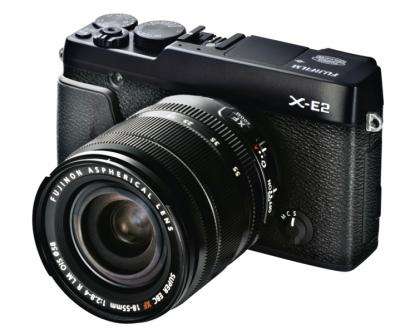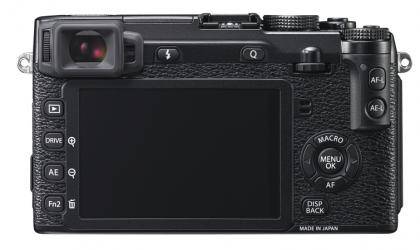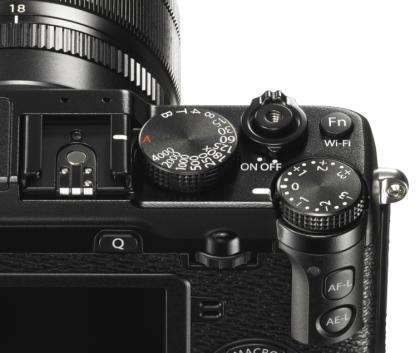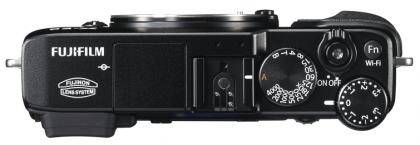Price, specs and rating for 18-55mm kit
The last few months have been an exciting time for anyone on the market for a premium compact system camera (CSC). Manufacturers are increasingly designing CSCs aimed squarely at enthusiasts, and the best models have no trouble competing with similarly priced SLRs.
The Fujifilm X-E2 is in esteemed company, sitting below the Fujifilm X-T1 and above the Fujifilm X-M1 in Fujifilm's X-Mount line-up. As is common with CSC and SLR ranges, image quality is fairly uniform across all three models, and it's their features and performance that separate them. The X-E2 is housed mostly in magnesium alloy – a welcome upgrade from the plastic X-M1 but a notch down from the weather-sealed magnesium alloy X-T1.

This isn't the smallest or lightest CSC around but build quality is superb. We'd have liked a slightly bigger grip, though. This can be added via an optional add-on unit (part MHG-XE) but it's not cheap at around £100. A larger integrated grip might have provided room for a side-mounted card slot. Instead, it's located beside the battery so it can't be accessed when the camera is tripod mounted.

While the X-M1 lacks a viewfinder, the X-E2 has a large, detailed (1,024x768-pixel) electronic viewfinder (EVF), complete with an eye sensor so that the camera automatically switches between its LCD screen and EVF. It isn't as big as the X-T1's positively enormous EVF, though.
Fujifilm X-E2 Handling
There are dedicated dials for shutter speed and exposure compensation, plus a lens ring on the kit lens for aperture control – all features missing from the X-M1. This means there's no need for a mode dial; program, aperture-priority, shutter-priority and manual exposure are accessed simply by turning the aperture, shutter or both controls from their Auto setting to a specific value. It's also possible to set the shutter speed and aperture manually but still achieve automatic exposures by leaving the ISO speed set to Auto. However, unlike on the X-T1, the exposure compensation dial doesn't have any effect in this mode. The X-T1 also has various additional physical controls, including an ISO speed dial, switches for drive mode and metering, plus a dedicated video record button.

The X-E2 isn't exactly short of controls, though. There are labelled buttons for drive mode, metering mode, AF lock, AE lock, macro and AF area, plus two customisable buttons assigned to ISO speed and white balance by default. Pressing the Q button brings up a four-by-four grid of functions, navigated with the rear pad and adjusted with the command dial.

Fujifilm X-E2 Performance
Continuous performance is neatly in line with the three cameras' prices. The X-E2 managed 6.9fps in our tests, nestling neatly between the X-M1 at 5.5fps and the X-T1 at 8.3fps. The X-E2 slowed after 18 JPEGs, but only very slightly, to 5fps. RAW continuous shooting inevitably slowed more abruptly, dropping to 1.1fps after eight frames. The X-T1's larger buffer meant it could continue shooting RAW frames at 8.3fps for 20 frames.
Both the X-E2 and X-T1 include phase-detect autofocus points built into the main imaging sensor, which speed up autofocus times. Autofocus was reasonably nippy on the X-M1 too, but without having the two cameras side by side, we'd tentatively say that the X-E2 was a little faster. However, shot-to-shot times in normal use were no faster than from the X-M1, averaging one second. The X-T1 was quicker at 0.7 seconds. Most premium CSCs come in at less than half a second in this test.
Wi-Fi is built into all three models, but only the X-T1 supports remote shooting from its accompanying iOS and Android apps. The X-E2 uses the same app as the X-M1, which is limited to image transfers and a rather clumsy geo-tagging function with the help of a phone's GPS radio.
A couple of features are out of kilter with the three models' prices. There's an integrated pop-up flash – a feature that the X-T1 foregoes in favour of a removable flash unit. The X-T1's flash is slightly more powerful but we prefer the X-E2's flash's integrated design, and also its ability to be tilted upwards to bounce light off the ceiling. The X-E2 is the only one of the three not to include an articulated screen. This will bother some people more than others, but the superb EVF arguably makes it less of a concern.